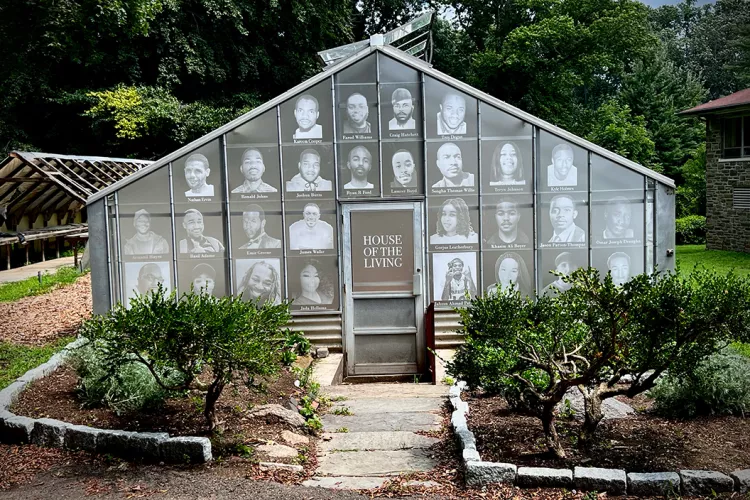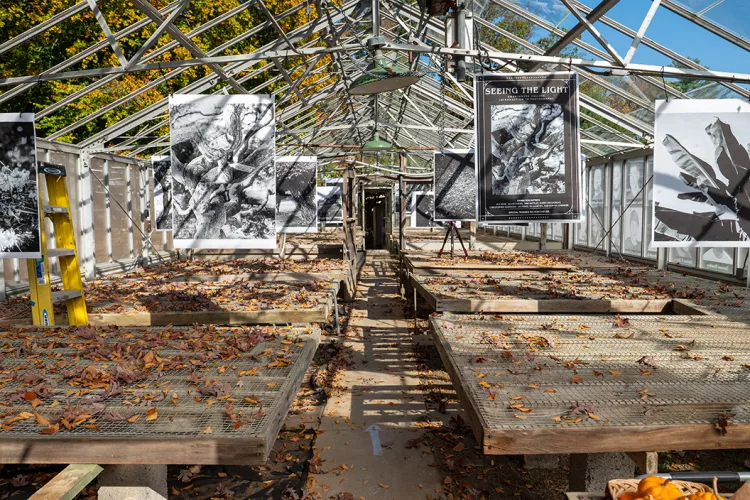Swarthmore Students, Faculty Collaborate on Greenhouse Monument to Homicide Victims

House of the Living hopes to replace all 410 panels, a figure that approximates the average homicide victims in Philadelphia every year. They have installed 90 portraits so far.
An overgrown greenhouse turned monument to homicide victims is being brought to life in a collaboration between Associate Professor of Art Ron Tarver, Assistant Professor of Art Jody Joyner, Swarthmore art students, EMIR Healing Center, and FarmerJawn.
The multiyear project, called House of the Living, is about 25% of the way done. Throughout 2023, the group made significant progress with the funds from a Lang Center for Civic & Social Responsibility grant, as well as contributions from Swarthmore students Miranda Kashynski ’24, Angie Kwon ’24, Jake Vercellino ’24, and Bryn Mawr student Teri Ke ’24.
On Swarthmore’s end, the project is being led by Tarver and Joyner. Tarver, an esteemed photographer, is the visionary behind the project concept and name. Joyner, who specializes in sculpture and installation, incorporated House of the Living into two courses during the 2022-2023 academic year.
Joyner’s Sculpture and the Environment course focused on the project for the majority of the spring semester. Student involvement included interviewing people who have lost family members to violence, testing materials and developing the process for creating the panels, operating the MakerSpace laser cutter to etch portraits, creating 3D renderings and physical models of the greenhouse, and website design. The class installed the first 45 portrait panels on site at the greenhouse for their final project.
Kashinsky ’24, who has continued to work on the project even after her class with Joyner ended, explains why it’s difficult to package up a neat description of House of the Living.
“The project really isn’t simple,” she says.

The inspiration came to Tarver in 2020 after his dog, Winston, led him to a greenhouse in Elkins Park that he’d never noticed.
The monument’s creation process relies on open communication with the families involved and is facilitated by trauma-informed professionals from EMIR Healing Center. For a portrait to be included, a family member must approve of their loved one being portrayed by the House of the Living; that approval comes after info sessions and individual interviews. Many of those interviews are conducted by Swarthmore students, all of whom were trained by EMIR counselors on how to use trauma-informed language, ensuring that the process lives up to its goal of being an avenue for healing.
EMIR Healing Center Co-Founder & President Chantay Love told the Philadelphia Citizen, “They had to have an awareness of what families and individuals go through when they lose someone. So that’s what some folks may not see is a big thing — you asking a family, ‘So, well, tell me what happened.’ That’s traumatizing. And you don’t always need the story to understand or have compassion for a person.”
EMIR Healing Center is an organization that has been providing trauma and survivor services for co-victims of homicide in Philadelphia for over two decades. EMIR is named after Emir Greene, a son, brother, and artist who loved to draw. Greene fell victim to homicide in Philadelphia on March 26, 1997. Since his passing, Emir’s family – including sisters Love and Community Coordinator Aja King – have been dedicated to helping others heal through the organization. Love, King, Program Director Sharon Patton-Thaxton, and EMIR’s team of counselors play an integral role in House of the Living.
“It isn’t the crime scene or the tape, it’s their life being shared. The interviews help people see their loved ones as still alive, and how they saw them – funny, happy, etc. It offers an alternative way to heal, through art, and through changing the environment. It’s an awareness process that addresses violence and allows people who have been impacted to take ownership,” says Love.

Swarthmore students help renovate the greenhouse and prepare it for the House of the Living exhibition.
On October 28, 2023, House of the Living held an unveiling for the families of the 90 people memorialized so far. Inside of the greenhouse, prints by Tarver’s Introduction to Photography students were displayed, giving a sense of how the space is intended to serve as a venue for a variety of artistic events. The photographers featured included Alex Dow ’27, Alvin Zheng ’26, Ana Sattler ’26, Bobby Delgadillo ’27, Christopher Guerrero ’26, Jai Perez ’27, Silas Reyes ’27, and Sophia Springer ’26. Over 300 family members and friends of the commemorated victims attended, many of whom were seeing the monument for the first time.
The monument’s moniker is inspired by Octavia Butler’s 1993 science fiction novel Parable of the Sower. In the book, a teenage girl creates a religion to cope with the murders of her brothers and father, and as she fights to survive a disintegrating world. The religion’s central tenets are called The Book of the Living, and focus on embracing change and turning to the natural world for guidance. The novel had a resurgence of popularity during the pandemic as it is set in 2026 with environmental disaster, racial violence, and societal collapse.
“All that you touch
You Change.
All that you Change
Changes you.
The only lasting truth
Is Change.
God
Is Change.”
-The Book of the Living
Much like the prescient Parable of the Sower, Jeanine Armstrong from The Philadelphia Inquirer says the House of the Living “feels divinely inspired.”
The inspiration came to Tarver in 2020 while he was on a walk with his wife Kristin and their dog, Winston. Winston led them to a greenhouse that they’d never noticed on their many walks through the historic Elkins Estate. Vines and plants nearly consumed the otherwise ordinary greenhouse.
It’s ingrained in Tarver, who teaches Photography Foundations, to consider the intricacies of light; how it refracts, reflects, and casts shadows. Looking at the overgrown greenhouse with curiosity, he received a vision of transformation.
"The idea just occurred to me. What would happen if we etched portraits of gun violence victims into the glass, with the idea that the light shining through would nurture the plants inside?" Tarver said.
Tarver set out to contact whoever owned the greenhouse, but that information was impossible to come by as the borough's administrative buildings were shut down due to COVID-19. Empty-handed, aside from Winston’s leash, he continued to pass by the greenhouse on his walks, cultivating his vision. Over the weeks, he noticed that the greenhouse was evolving; vines were being removed, debris was being cleared out.

On October 28, 2023, House of the Living held an unveiling for the families of the 90 people memorialized so far. Inside of the greenhouse, prints from Tarver’s Introduction to Photography students were displayed. Photo by John Flak.
On one favorably timed walk, Tarver ran into Brandon Ritter, COO of FarmerJawn & Friends Foundation, who was responsible for the revitalization work being done on the greenhouse, and shared his vision of the monument. Ritter thought that Tarver’s vision aligned with FarmerJawn’s, which has a ten-year lease for the greenhouse property. The organization is a community-supported agriculture group, founded by Christa Barfield. FarmerJawn provides farm-fresh organic foods, and food education regarding politics and justice, to communities regardless of socioeconomic status. Once the greenhouse is functional, they will grow hardy greens, lettuce, squash, and tomatoes using regenerative practices. The fresh produce will then be provided to Philadelphia families in need.
After Ritter and Tarver met, they each engaged additional support to bring together what is now the project’s team: EMIR Healing Center, FarmerJawn, and students and faculty from Swarthmore College Art Department.
House of the Living hopes to replace all 410 panels, a figure that approximates the average number of homicide victims in Philadelphia every year. They have installed 90 portraits so far. In order to complete the project – which includes compensating grief counselors, completing engraved panels, repairing the building’s infrastructure, and improving the landscaping – the group estimates they will need at least $300,000. To learn more about or support House of the Living, visit their website.
Watch 6abc’s coverage of the House of the Living.



